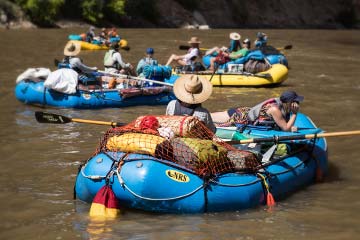How To Daisy Chain an NRS Tie-Down Strap
NRS 1" HD Tie Down straps make rigging rafts, tying down kayaks and securing gear on cars simple. But one question you may find yourself asking is what to do with the leftover length of webbing—the tail—after you’ve tightened down an NRS strap. In this video, we show you how to daisy chain the webbing on a tie-down strap, a simple and effective method for dealing with the strap tail to keep it out of the way.
Of course, the ideal solution is to pick a strap with just the right length. We try to help with 1', 2', 3', 4', 6', 9', 12', 15' and 20' choices, but certainly the length doesn’t always match the task. That’s where solutions like the strap daisy-chain come in handy.
As shown in the video, you make a loop in the strap, near the buckle, and pass a bight of the remaining webbing through the loop. Then you use that bight as a loop to pass the strap through, repeat, repeat, repeat as needed. Finish by tying off the end so your daisy chain doesn’t unravel prematurely.
One bit of “strap hygiene and management” know-how that isn’t common knowledge is anytime you are using a tie-down strap on a vehicle, where a section of the strap is not directly against something, put a “twist” in the strap in that area. This helps eliminate “strap strum,” the rhythmic vibration of the strap in the wind. Under the right conditions, this strum can generate enough energy to actually melt and part a strap. This also helps cut down on noise.
NRS straps are the best ones in the marketplace, and not just for boating. It’s amazing the number of uses customers report. Some of the more exotic have been lashing a tracking device to a Komodo Dragon and tying a Longhorn steer’s horns to a corral to immobilize him for medical attention.
As the saying goes, “NRS straps: you can never have too many!”
 NRS Gift Card: Always Fits, Always Wanted
NRS Gift Card: Always Fits, Always Wanted




